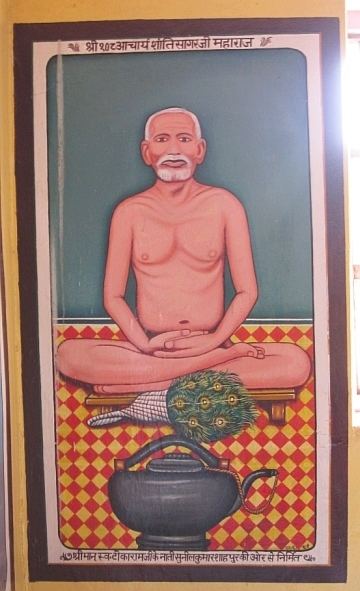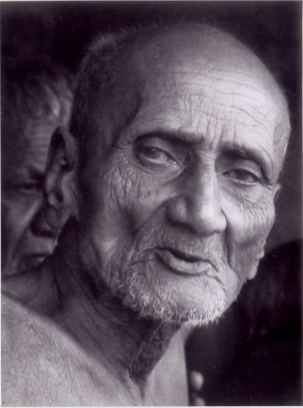Birth name Satgauda Name Shantisagar Shantisagar | New name given Shantisagar | |
 | ||
Died 18 September 1955(1955-09-18) (aged 82–83) Parents Bhimagauda Patil, Satyavati | ||
Muni shri shantisagar ji antim yatra samadhi 14
Acharya Shri Shantisagar (1872 - 1955) was an Indian monk of the Digambara school of the Jain faith. He was the first Acharya (preceptor) and a leader of his sect in the 20th century. Shantisagar revived the teaching and practice of traditional Digambara practices in Entire length and breadth ofIndia.
Contents
- Muni shri shantisagar ji antim yatra samadhi 14
- Shantisagar
- Life
- Death
- Pilgrimages
- Central India
- Northern India
- Western India
- Maharashtra
- Sallekhana Or Samadhi
- References

Shantisagar
Life
Shantisagar was born in either 1872 in yalgud (bhoj) in north Karnataka, India. His father was a religious person and was head of the village. They were farmers and hailed from kshatriya community. They also were cloth traders. {sfn|Desjarlais|Eisenberg|1996|p=82}} At age eighteen, having read religious texts and undergone several pilgrimages, Shantisagar decided to dedicate his life to a religious order.
Shantisagar's parents died in 1912. In 1914, he then traveled to Uttur, a village near stavnidhi kSetra (Tavandi in karnatak) and got kShullak diksha ( Small Monk) in the hands of Muni Devendrakirti. After Spending 4 chaturmas ( years) as kShullaka, He became ailak ( Close to Muni but for One Cloth) in Sidhdhakshetra girnar and in 1920 he Shantisagar became a monk of the Digambara sect of Jainism. id=6AkE52aoFvoC&pg=PA82&dq=shantisagar&hl=en&sa=X&ved=0ahUKEwi2neqR8sHUAhUCX5QKHXwBAocQ6AEIMjAD#v=onepage&q=shantisagar&f=false World Mental Health] Oxford University Press, 1995 p82. ISBN 019511311X, 9780195113112
Muni Shree 108 Shantisagar Maharaj preached the principles of Jainism in various parts of India and became an Acharya. in 1924 in presence of chaturvidh sangh and thousands of laymen in kognoli. His disciples also called him "Charitra Chakravarti" ("Emperor Emperor of good character"). He has also been called "muniraj" ("King among Ascetics"), and "shil-sindhu" ("Ocean of Observances").
He is regarded as re-surrector of naked ascetics in 20th Century after onslaught of Mughals, British and hindu faiths. Even after a Century of his becoming a monk he is revered and worshipped across the entire digambar jain community.
Death
Regarding the observance of the sallekhana vow, a Jain death ritual, by Acharya Shee 108 Shantisagar, Padmanabh Jaini writes:
108 Shree Muni Shantisagar took last breath on 18 September 1955 at 6:50 am at Kunthalgiri, Osmanabad district, Maharashtra, India.
Pilgrimages
Based on the accounts given by Sumeruchandra Diwakar and Dharmachanda Shastri, Shantisagar was born in 1872 to Bhimagauda Patil and Satyavati at Yelagula (Bhoj), Karnataka, India. His birth name was Satgauda. He was married at the age of nine. His wife died six months after the marriage. In 1905, he made a pilgrimage to Sammed Shikhar accompanied by his sister.
In 1925, Shantisagar was present in Kumbhoj township. He attended the Mahamastakabhisheka (grand consecration) at Shravanbelgola, Karnataka. In 1926, he visited Nanded city, Maharashtra. In 1927, he visited Bahubali, Maharashtra and then Nagpur which was then the capital of the Cetral provinces.
Shantisagar then travelled in east India. He had a Panchakalyanaka blessing at Sammed Shikhar, Bihar, a Jain pilgrimage site. He also travelled to Champapur and Pavapur.
Central India
In 1928, Shantisagar visited central India. He visited towns including Katni in Madhya Pradesh state, Jabalpur, Sleemanabad, Nohta, Kundalpur and Sagar. In Dronagir, Shantisagar encountered a tiger. By 1929, Shantisagar was in Lalitpur. In Sonagir, four ailaks (researchers). By 1929, Shantisagar was visiting Gwalior and Murena.
Northern India
Shantisagar travelled to north India. In Rajakheda, Uttar Pradesh, Shantisagar was attacked by a violent crowd. Shantisagar visited Agra, Hastinapur and Firozabad. In 1930, Shantisagar visited Mathura and received a blessing. Shantisagar's presence in Delhi in 1931 is marked by a memorial at Lal Mandir.
Western India
In the 1930s, Shantisagar travelled through west India. He visited the Shri Mahaveer Ji temple, a Jain pilgrimage site. Shantisagar visited Jaipur in 1932, Byavur in 1933, Udaipur in 1934, Goral in Gujarat in 1935, Pratapgarh in 1936 and Gajpantha in Maharashtra in 1937. Around this time, Shri Shantisagar Charitr was written by Muni Kunthusagar in Sanskrit and in Gajpantha, Shantisagar was given the title, "Charitra Chakravarti". In 1938, Shantisagar visited Baramati, Indore city in Madhya Pradesh. In 1939, he visited Pratapgarh in Uttar Pradesh.
Maharashtra
In the 1940s, Shantisagar travelled through Maharashtra state. He visited Goral in 1940, Akluj in 1941, Korochi in 1942, Digraj in 1943, Kunthalgiri in 1944, Phaltan in 1945, and Kavalana in 1946. Then in 1947, at the time of Partition, Shantisagar was in Sholapur. In a miracle, in Shantisagar's presence, a mute young man began to speak. In 1948, Shantisagar was in Phaltan. He was in Kavlana in 1949.
In the 1950s, Shantisagar continued to travel in Maharashtra state. He was in Gajpantha in 1950, Baramati in 1951, Lonand in 1952, and Kunthalgiri in 1953. In 1953, Sumeruchandra Diwakar's book, Charitra Chakravarti was published. In 1954, there was preservation of the Dhavala books.
Sallekhana Or Samadhi
In 1955, Shantsagar arrived in Kunthalgiri town. On 18 September 1955, he commenced the practice of Sallekhana, a gradual reducing of intake of fluid and food leading to death. Sumeruchandra Diwakar, Bhattarakas Lakshmisen and Jinasen arrived in the town. Acharya shantisagar attained utkrushta samadhimaran in 35th / 36th day.The title of Acharya pada (teacher of philosophy) was awarded to Muni Virasagar.
